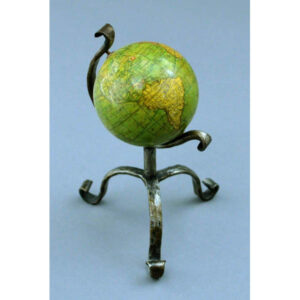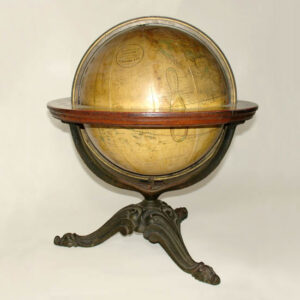Description
The temple in this view was dedicated to Khnum, the ram-headed Egyptian god who is said to have created humankind out of clay. It was begun by King Ptolemy VI Philometor (reigned 180 to 145 BC). The Romans later added the only portion that can be visited today, the hypostyle hall with 18 columns richly decorated with varied floral capitals and pillars covered with hieroglyphic accounts of temple rituals. Carvings on one wall date from Ptolemy’s original temple, and others from as late as the 3rd century AD. The temple was abandoned during the Roman period and today sits in a pit that is nine meters deep with the original structure mostly unexcavated and buried beneath the town.
David Roberts was born in Edinburgh, Scotland. He began his career as a house painter and by 1816 was painting stage scenery for the theatre. In 1820 he met Clarkson Stanfield, who encouraged him as an artist, and in 1821 he moved to London, where he worked with Stanfield on sets at the Drury Lane Theatre. Roberts exhibited at the first show held by the Society of British Artists, and was able to become a full-time fine art painter in 1830. During the early 1830s he began to produce the sketches of foreign lands that were to make him famous, beginning with Spain. In 1838 and 1839 he undertook an extensive and adventurous journey to Alexandria, Cairo, and other places in the Middle East, making extensive sketches. He recorded broad vistas of the ancient world with local inhabitants, as well as detailed studies of classical architectural ruins. In the 1840s, over a period of seven years, lithographs of his sketches of the Middle East, together with text, were published in 41 parts in The Holy Land, Syria, Idumea, Arabia, Egypt and Nubia. According to J.R. Abbey, this work forms “one of the most important and elaborate ventures in nineteenth-century publishing, and … the apotheosis of the tinted lithograph.” Roberts also produced an illustrated work on Italy in the 1850s. His paintings are in many museum collections, including the Victoria and Albert Museum, London.
Louis Haghe was a Belgian-born painter, watercolorist and lithographer, who spent his career in England after arriving in London in 1823. In 1830, he and his partner William Day formed the successful lithography firm of Day & Haghe, where they were known for their advanced work in color lithography. In 1838 they were appointed lithographers to Queen Victoria. Haghe was also one of the founders of the New Society of Painters in Water-Colours and served several years as president. As a watercolorist, his principal subjects were rural landscapes and villages in the North of France and the Low Countries.His major works also include three volumes of lithographs based on sketches of Germany and Belgium, published in London between 1840 and 1850. During his long career he frequently exhibited his works in Paris and London. Today his watercolors are in the collections of the Victoria and Albert Museum, and the art museums of Brussels, Leicester, Manchester and other cities.
Inscription in matrix lower right: Temple at Esneh Nov 25th 1838 David Rogers R.A. L. Haghe lith.
Condition: Generally very good with only minor overall toning and wear. Tipped on card, as issued.
References:
Abbey, J.R. Travel in Aquatint and Lithograph 1770-1860. San Francisco: Alan Wofsy Fine Arts, 1991 (reprint of 1957 edition). 272, 385.
Bénézit, E.Dictionnaire critique et documentaire des Peintres, Sculpteurs, Dessinateurs et Graveurs. France: Librairie Gründ, 1966. Vol. 4, p. 551.
“David Roberts.”The Grove Dictionary of Art.New York: Macmillan. 2000. Artnet.com. http://www.artnet.com/library/07/0724/T072403.asp (31 March 2003).
David Roberts’ Egypt and the Holy Land. London: The Schuster Gallery, 1987. Item 149.
“Lot 234, Important British Drawings, Watercolours and Portrait Miniatures.” Sotheby’s. 2006. http://www.sothebys.com/en/auctions/ecatalogue/lot.234.html/2006/important-british-drawings-watercolours-and-portrait-miniatures-l06171 (29 September 2020).
Sim, Katharine. David Roberts R.A. 1796-1864, A Biography. London: Quartet, 1984.
“Temple of Khnum.” Lonely Planet. 2020. https://www.lonelyplanet.com/egypt/nile-valley/esna-to-abu-simbel/attractions/temple-of-khnum/a/poi-sig/1073700/1298042 (29 September 2020).








